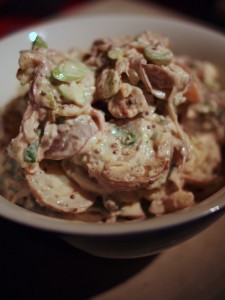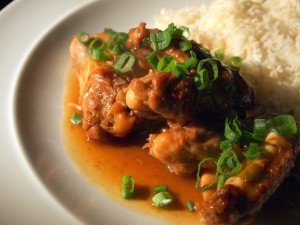
So now you’ve got your hands on some really fine mayonnaise, you’ll be wanting to use it to make a really fine potato salad. The ingredients list here is a simple one. Use the best waxy little potatoes you can; I used Roseval, which have a sweet, yellow flesh sometimes tinged with red rings. Pink Fir Apple, all knobbly and smooth-skinned, are another favourite, but Jersey Royals are best of all, and this is a great way to showcase their delicate flavour during their short season (around May and June). Don’t peel your potatoes or scrub off their delicate skins when you clean them; much of the potato’s flavour is held just below the skin, and the tasty skins themselves are a good source of vitamin C.
You can boil or steam your potatoes. Many varieties of new potato are perfectly happy being boiled, but if you’re not familiar with the variety you’ve chosen, steam them – they’re less likely to crack or collapse this way.
The sweet red onions in this salad should be sliced as fine as you possibly can. They’re less harsh this way, and their flavour gently infuses the whole salad. If you have a mandoline (mine, which I love and fear in equal measure, was a present from my lovely in-laws – I am pretty sure they are not trying to kill me, but that rather, they imagine I’m actually competent around razor-sharp blades), set it to slice paper-thin. If you’re using a knife, sharpen it before you start on the onion to help you slice thinly.
To make enough potato salad for a side-dish for four, you’ll need:
500g new potatoes
3 spring onions
½ red onion
2 tablespoons mayonnaise
2 tablespoons crème fraîche
1 teaspoon nonpareil capers, drained of their vinegar
1 heaping teaspoon grainy Dijon mustard
1 tablespoon parsley, chopped finely
Steam or boil the potatoes for 20 minutes, and allow to cool to a point where you can handle them. While the potatoes are cooling, slice the red onion into paper-thin half-moons, and chop the spring onions on the diagonal into 1cm pieces. Mix together the mayonnaise, crème fraîche, capers, mustard and parsley in a bowl.
Cut the warm potatoes into slices and toss them well with the onions in a serving bowl. Pour over the dressing, toss again and serve. You shouldn’t need any additional salt, but taste to check and season if you want to.

